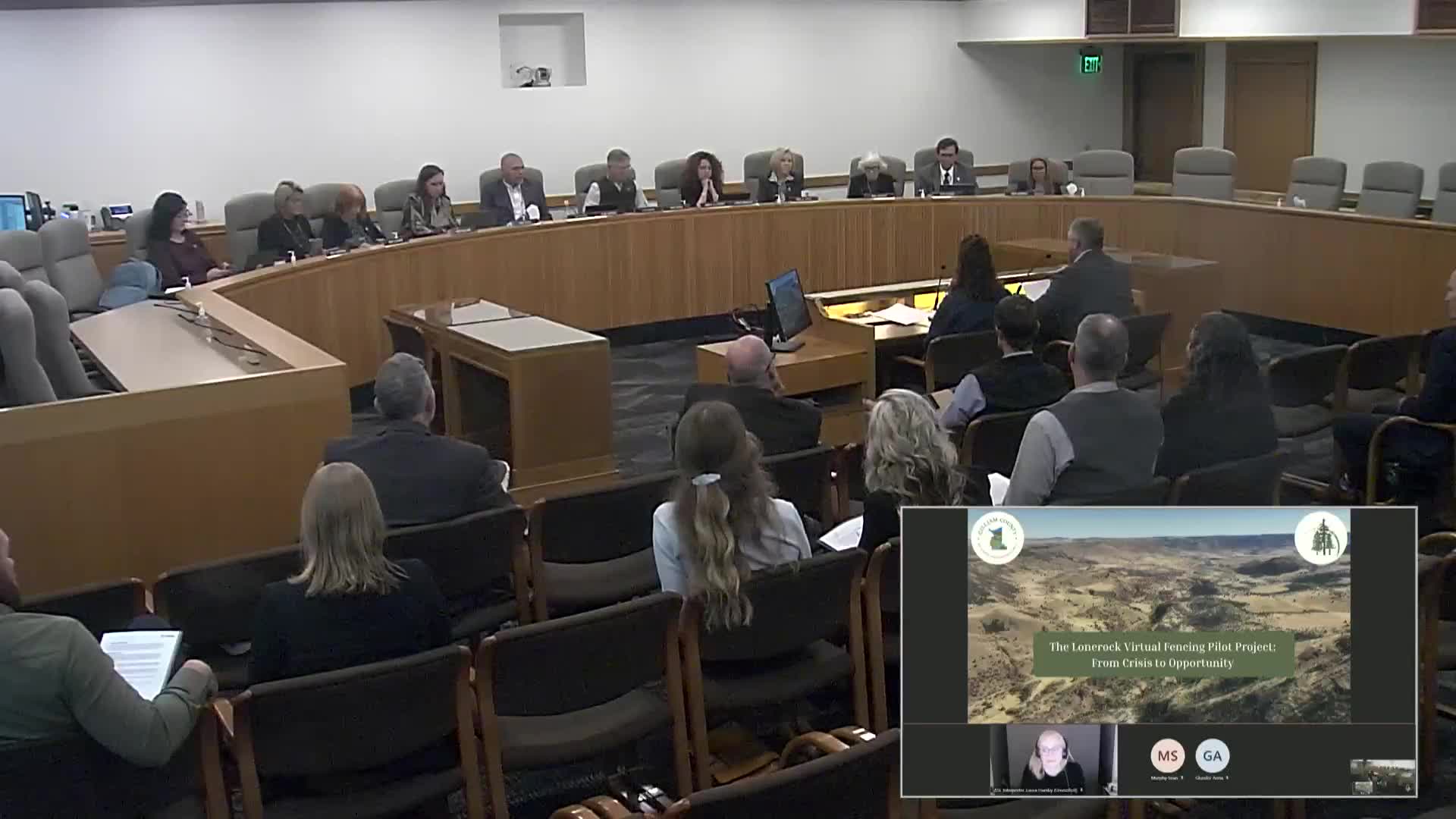Gilliam County pilot shows virtual fencing helped ranchers recover after Lone Rock Fire, academics say
November 17, 2025 | Legislative, Oregon
This article was created by AI summarizing key points discussed. AI makes mistakes, so for full details and context, please refer to the video of the full meeting. Please report any errors so we can fix them. Report an error »

County officials, ranchers and researchers told the interim committee a local virtual‑fencing pilot deployed after the July 2024 Lone Rock Fire delivered rapid operational benefits for ranch recovery while raising questions about connectivity, animal welfare settings and capital costs.
Herb Winters, district manager of the Gilliam Soil and Water Conservation District, said the Lone Rock Fire began July 13, 2024, burned about 137,000 acres in the region and destroyed hundreds of miles of fence. With traditional fence rebuilding timelines and costs (Herb told the committee roughly $9,500,000 to replace more than 300 miles of fence), the SWCD pursued virtual fencing as an emergency, fast‑moving solution. "Once we recognized virtual fencing as the immediate solution, we went to work and within 39 days of the fire start, we secured funding...and launched the pilot," Winters said. Local funding came from Gilliam County, the Ford Family Foundation and the SWCD general fund.
Ranchers who used the system described operational payoffs. Jason Campbell said initial testing and later broader collaring allowed his operation to use pastures that otherwise would have been unusable and to return many cattle home up to a year earlier than anticipated. Anthony Campbell said the collars enabled easier mustering and rotation and helped keep cattle away from riparian and burned zones where recovery was needed.
Research results: David Bohnert of Oregon State University’s Eastern Oregon Agricultural Research Center summarized peer‑reviewed studies and pilot monitoring. He said a pre/post fire study showed forage utilization in burned riparian areas fell to less than 3% with active virtual fencing compared with about 70% without collars, meeting the management objective to protect recovering riparian ground. He also described virtual‑fence‑based fuel breaks that reduced standing forage by about 49% in trials and said the data are being prepared for publication.
Technical limits and animal welfare: Presenters emphasized the system relies on cellular connectivity for real‑time monitoring and reprogramming; collars retain boundary data offline but real‑time visibility requires some signal. Committee members asked about terrain, persistent "habitual" animals that breach boundaries, and safety settings: presenters said collars include an animal‑welfare cutoff that disables the shock after repeated activations and that settings and placement of boundaries must be adjusted according to water access, terrain and social behavior.
Costs and scalability: Witnesses cited tower equipment roughly at $10,000 each and noted capital costs can be a barrier for counties without local grant funds. Winters and Judge Chris Patnode argued pooled local grants and targeted state support could allow other counties to replicate the model.
Closing: Committee members thanked presenters and discussed possible state‑level funding options to replicate the emergency deployment model. The hearing closed with the committee acknowledging the pilot’s demonstrated utility and the need to explore funding and connectivity solutions.
Herb Winters, district manager of the Gilliam Soil and Water Conservation District, said the Lone Rock Fire began July 13, 2024, burned about 137,000 acres in the region and destroyed hundreds of miles of fence. With traditional fence rebuilding timelines and costs (Herb told the committee roughly $9,500,000 to replace more than 300 miles of fence), the SWCD pursued virtual fencing as an emergency, fast‑moving solution. "Once we recognized virtual fencing as the immediate solution, we went to work and within 39 days of the fire start, we secured funding...and launched the pilot," Winters said. Local funding came from Gilliam County, the Ford Family Foundation and the SWCD general fund.
Ranchers who used the system described operational payoffs. Jason Campbell said initial testing and later broader collaring allowed his operation to use pastures that otherwise would have been unusable and to return many cattle home up to a year earlier than anticipated. Anthony Campbell said the collars enabled easier mustering and rotation and helped keep cattle away from riparian and burned zones where recovery was needed.
Research results: David Bohnert of Oregon State University’s Eastern Oregon Agricultural Research Center summarized peer‑reviewed studies and pilot monitoring. He said a pre/post fire study showed forage utilization in burned riparian areas fell to less than 3% with active virtual fencing compared with about 70% without collars, meeting the management objective to protect recovering riparian ground. He also described virtual‑fence‑based fuel breaks that reduced standing forage by about 49% in trials and said the data are being prepared for publication.
Technical limits and animal welfare: Presenters emphasized the system relies on cellular connectivity for real‑time monitoring and reprogramming; collars retain boundary data offline but real‑time visibility requires some signal. Committee members asked about terrain, persistent "habitual" animals that breach boundaries, and safety settings: presenters said collars include an animal‑welfare cutoff that disables the shock after repeated activations and that settings and placement of boundaries must be adjusted according to water access, terrain and social behavior.
Costs and scalability: Witnesses cited tower equipment roughly at $10,000 each and noted capital costs can be a barrier for counties without local grant funds. Winters and Judge Chris Patnode argued pooled local grants and targeted state support could allow other counties to replicate the model.
Closing: Committee members thanked presenters and discussed possible state‑level funding options to replicate the emergency deployment model. The hearing closed with the committee acknowledging the pilot’s demonstrated utility and the need to explore funding and connectivity solutions.
View the Full Meeting & All Its Details
This article offers just a summary. Unlock complete video, transcripts, and insights as a Founder Member.
✓
Watch full, unedited meeting videos
✓
Search every word spoken in unlimited transcripts
✓
AI summaries & real-time alerts (all government levels)
✓
Permanent access to expanding government content
30-day money-back guarantee

